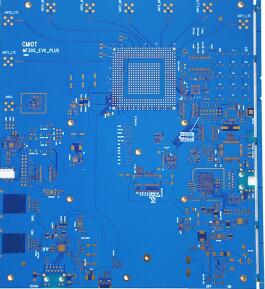The PCB substrate of the fingerprint module soft board factory is composed of three main components: Cooper Foil, Reinforcement, and Epoxy. Since the lead-free process started, the fourth item Fillers have been added to the PCB in large quantities to improve the heat resistance of the PCB.
Introduction to the structure and function of PCB board
We can think of copper foil as the blood vessels of the human body, which is used to transport important blood, so that the PCB can play a role; the reinforcing material can be thought of the bones of the human body, which is used to support and strengthen the PCB so as not to soften down; and the resin It can be imagined that the muscles of the human body are the main component of PCB.
Let's talk about the uses, characteristics and precautions of these four PCB materials.
1, Copper Foil (copper foil layer)
Electric Circuit: Conductive circuit.
Signal line: The signal (signal) line for sending messages.
Vcc: power layer, working voltage. The working voltage of the earliest electronic products is mostly set to 12V. With the evolution of technology and the requirements for power saving, the working voltage has gradually become 5V, 3V, and now it is gradually moving to 1V, and the requirements for copper foil are also increasing. Come higher.
GND (Grounding): Grounding layer. Think of Vcc as a water tower. When the faucet is turned on, water (electrons) will flow out through the pressure (working voltage) of the water, because the action of electronic parts is determined by the flow of electrons; while GND can Imagine it as a sewer, where all used or unused water flows away through the sewer.
Heat Dissipation: for heat dissipation. Most electronic components consume energy to generate heat. At this time, it is necessary to design a large area of copper foil to release the heat into the air as soon as possible, otherwise not only humans will not be able to bear it, but even electronic components will also crash.
2, Reinforcement (reinforcement material)
When selecting PCB reinforcement materials, the following excellent characteristics must be possessed. And most of the PCB reinforcement materials we see are made of glass fiber (GF, Glass Fiber). If you look closely, the material of glass fiber is a bit like a very thin fishing line. Because of the following individual advantages, it is often selected When the basic material of PCB.

High Stiffness: With high rigidity, the PCB is not easily deformed.
Dimension Stability: It has good dimensional stability.
Low CTE: It has a low thermal expansion rate to prevent the circuit contacts inside the PCB from detaching and causing failure.
Low Warpage: It has low deformation, that is, low bending and warpage.
3, Resin Matrix (resin mixed material)
The fingerprint module soft board factory mainly uses Epoxy in the traditional FR4 board, while the LF (Lead Free)/HF (Halogen Free) board uses a variety of resins and different curing agents to match it, which increases the cost. LF is about 20%, and HF is about 20%. 45%.
HF sheet is easy to be brittle and cracked, and the water absorption rate becomes larger. CAF is prone to occur in thick and large sheets. It is necessary to switch to open fiber cloth and flat fiber cloth, and strengthen the material with uniform impregnation.
A good resin must meet the following conditions:
Heat Resistance: Good heat resistance. After heating and welding two to three times, the plate will not burst, which is called good heat resistance.
Low Water Absorption: Low water absorption. Water absorption is the main cause of PCB explosion.
Flame Retardance: Must have flame retardancy.
Peel Strength: It has high tear strength.
High Tg: High glass transition point. Most materials with high Tg are not easy to absorb water. Non-absorption is the root cause of failure, not because of high Tg.
Toughness: Good toughness. The greater the toughness, the less likely it is to burst. Toughness is also called failure energy. The better the toughness of the material, the stronger the ability to withstand impact and endure damage.
Dielectric properties: High dielectric properties, that is, insulating materials.
4, Fillers System (powder, filler)
The temperature was not very high during the early lead soldering. The original PCB board of the fingerprint module soft board factory can be tolerated. Since the lead-free soldering has been introduced, the temperature has increased, so the powder will be added to the PCB board. PCB material that resists temperature.
Fillers should be coupled first to improve dispersion and adhesion.
Heat Resistance: Good heat resistance. After heating and welding two to three times, the plate will not burst, which is called good heat resistance.
Low Water Absorption: Low water absorption. Water absorption is the main cause of PCB explosion.
Flame Retardance: Must have flame retardancy.
High Stiffness: With high "rigidity", the PCB is not easily deformed.
Low CTE: It has a low thermal expansion rate to prevent the circuit contacts inside the PCB from detaching and causing failure.
Dimension Stability: It has good dimensional stability.
Low Warpage: It has low deformation, that is, low bending and warpage.
Drill processibility: Because of the high rigidity and toughness of the powder, it is difficult to drill the PCB.
Heat Dissipation (due to high thermal conductivity): for heat dissipation.